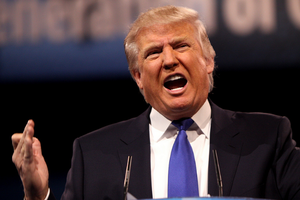Wow. I didn’t see that coming. Like most everyone else, I expected to see a comfortable Clinton win. I thought the big question was whether Republicans might find a way to hold the U.S. Senate. And then Trump happened.

Trump narrowly beat Hillary Clinton, piercing the Democrats’ “blue wall.” The Republicans lost a handful of seats but held their solid majority in the House. The GOP wound up narrowly holding the Senate—with Wisconsin’s Ron Johnson, Missouri’s Roy Blunt, Pennsylvania’s Pat Toomey, North Carolina’s Richard Burr, and several others fending off fierce challenges.
In other words, Trump had no coattails, but the result is that a Republican president is going to take office with Republican majorities in both houses of Congress for the first time since 1928. Yep, 1928.
What does this mean for education?
For starters, the period between now and inauguration is going to be cacophonous. Tomorrow, the stock market will melt down. There will be bitter recriminations and anti-Comey diatribes on the left. There will be fierce clashes on the right between Trump and the GOP’s Washington establishment. Trump may push to unseat House speaker Paul Ryan. The Washington Post and New York Times are unlikely to ease up in their heated attacks. The press will revisit all of Trump’s various scandals—ranging from Trump U. to the allegations of sexual assault. And then we’re going to start talking about the insanity of an Obama-to-Trump transition. In other words, the idea that we’re finally going to get clarity on Trump’s policy agenda is a pipe-dream.
Once we get to 2017, Trump and the congressional Republicans will have a sprawling agenda ahead of them—and education isn’t high on it. They’ve pledged to repeal and replace the Affordable Care Act. Trump has pledged to tear up Obama’s Iran treaty (remember, it’s just an executive agreement—it was never ratified by the Senate). There’s a Supreme Court vacancy. Trump has promised a massive tax cut. Trump has promised to start building a wall on the southern border and to reverse Obama executive actions on immigration. Trump and Hill Republicans want to unwind a raft of Obama administration regulations.
When education does come up, who really knows what a Trump administration would actually try to do on schooling? Sure, Trump’s said some things. He said he wants to spend $20 billion for some kind of federal program to promote school choice. He said he wants to abolish the Department of Education. He said that he wants to prohibit states from making schools gun-free zones. I think it’s a mistake to take any of this at face value. As I’ve noted before, “There’s no reason to believe that Trump necessarily means what he’s said on any issue. In truth, he seems to regard policy declarations as performance art.” So we’ll see if he devises a clear agenda on school choice or higher education, and whether he pushes it.
An old Washington saying is that “personnel is policy.” That is truer than ever when it comes to Trump. We’ll have to see who winds up getting named to key policy positions in the White House and the Department of Education. Will VP Mike Pence (a strong school choice advocate) exert any influence? Wisconsin governor Scott Walker campaigned hard for Trump in the end, delivering his crucial state. Will Trump name him to the cabinet, and might Walker wind up as Secretary of Education? A lot will depend on the people running the Trump transition and how much leeway they have to operate.
And understand that things will be hectic on the right. A lot of influential Republicans were NeverTrump. Key congressional leaders, like speaker Paul Ryan and majority leader Mitch McConnell, have been at odds with Trump. Trump has made noises about trying to oust Ryan, but presidents have historically fared poorly when they try to play kingmaker on Capitol Hill. There’s a good chance that you’ll ultimately see a congressional agenda—championed by the conservative policy-wonk wing of the GOP—competing with the Trump agenda. Only time will tell how this works itself out.
We’re also looking at a big “chickens-coming-home-to-roost” factor. President Obama stood up a few years ago and bragged about his intent to govern with his “pen-and-phone.” He was cheered enthusiastically on the left and the Obama administration turned its lawyers loose. They devised novel ways to extend the reach of Washington via “gainful employment,” Title IX, the redefinition of gender, guidelines governing Title I spending, and much more. At the time, some of us warned that the problem with concentrating all this authority in Washington was not only the resulting bureaucracy and the one-size-fits-all approach, but the fact that it made federal policy a winner-take-all proposition—which Democrats might regret if they found themselves on the outside.
Well, now the Dems are on the outside. All those policies imposed by pen-and-phone can be reversed as easily as they were imposed. More tellingly, the door has been opened for enthusiastic Trump appointees to get creative about pressing states to adopt school voucher programs, abstinence-only sex education, biologically-aligned locker rooms, curbs on PC-speech-restrictive policies on college campuses, and whatever else they can dream up. I think that would be an unfortunate use of federal power, but it’s hard to see how those who fear what Trump appointees might do can suddenly discover the virtues of federalism or executive restraint.
What’s the bottom line for K-12, pre-K, or higher education? I don’t know. And I’d be skeptical of anyone who claims that they do.
— Frederick Hess
Frederick Hess is director of education policy studies at AEI and an executive editor at Education Next.


